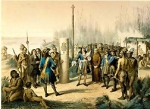April 4, 2011 Guest: Brenda Dardar-Robichaux The United Houma Nation, Louisiana
 April 4, 2011 Guest Brenda Dardar-RobichauxThe United Houma Nation, Louisiana – ‘The Houma Indian Nation Crisis’ Edit Text
April 4, 2011 Guest Brenda Dardar-RobichauxThe United Houma Nation, Louisiana – ‘The Houma Indian Nation Crisis’ Edit Text
The Houma Indians had been driven to the most isolated swamplands on this continent to find a place where they could independently maintain their Indian ways of life, language, medicine, arts, traditions and ceremonies. It would be hard for one to imagine the struggles the Houmas would face and be forced to endure in the years to follow before gaining state and federal recognition. The first written, historical mention of the Houmas occurred in 1682, when French explorer LaSalle noted a Houma village on the east bank of the Mississippi River opposite the Red River, near what is now West Feliciana Parish, LA. The total population of the tribe was estimated at between six hundred and seven hundred members at the time of the first encounter. By the beginning of the eighteenth century, about half the tribe died of disease introduced through contact with the Europeans.
The boundary line marker of the Houmas and the Bayougoulas Indians who lived to the south, was a tall red pole, topped with a bear head and several fish heads. This marked the hunting grounds for the two tribes. When the French first saw it, they referred to it as “le Baton Rouge”. The Houmas had many ways to obtain their food. The men were hunters and used the blow gun, made of local cane reeds, for small game such as turkey and rabbit. Darts were also made of bamboo. He became quite skilled with this weapon. For larger game, he used the bow and arrow, and the spear. Arrow points and spearheads were made from shell, also of stone and flint which were traded from the Indians to the north. Tomahawks were made of shell and stone. Sharp shells were used as knives, as were flint and sharp stones.
The Houmas worked community fields, sometimes up to several acres in size. Here they would grow such crops as melons, pumpkins, beans, and several varieties of corn. The women did the planting. To break up soil, she fashioned a hoe in the ground with a stick, dropped in a seed and covered it over by hand. At harvest time she gathered the crops and stored them in community bins. These were built on stilts about 12 feet high and were kept highly polished to keep the rats away. The Houmas spoke the Muskhogean language. Their language was used by most of the tribes in south Louisiana because it was easier to speak. As the white man came in, they adopted the French tongue and eventually English. The red crawfish was the war emblem of the Houmas, although they were not warlike people. It helped identify them from other tribes.
As far as we know, the dugout pirogue was the only kind of boat the Houma used. Before advent of the steel ax, the Indian felled a cypress tree by fire. He then made another fire to eat through the other end. Still another fire was kept going in the middle to eat away at the insides until the desired width and depth was achieved. Because of conflicts with the Tunica Indians and colonial tensions between the French and English, the Houmas began migrating south. By the late eighteenth century, the Houmas had settled in what is now Terrebonne Parish. They gradually occupied the bayou marshlands from Dularge in Terrebonne Parish to Golden Meadow in Lafourche Parish. Some took up farming, and many others took up hunting, trapping, and fishing in their struggle to survive. Many of their descendants continue in these occupations today, living in or near the same places where their ancestors lived. Houmas have traditionally maintained close kinship and friendships, and are tied to members in other areas through their extended families.
The children of the Houma tribe from the isolated rural areas of south Louisiana were educationally under-served for over two centuries. During the first half of the twentieth century, and well into the 1960’s the Houmas were still struggling for the right to have their own schools. Denied admission to public schools, many remained largely uneducated until 1963, when they received access to public school on an equal basis. The tribe continues to struggle to overcome the disparities resulting from inexplicably long years of educational neglect. Throughout the struggles over land, education and trapping rights both the tribe and friendly whites appealed to the federal government for help. However, the Bureau of Indian Affairs has continued to ignore its responsibility to these Indian people. Its failure to acknowledge the Houmas continues to cripple the tribe by excluding it from the full range of federal services to which it is entitled. The United Houma Nation, Inc., the governing body of today’s Houma’s, compiled a petition for the federal recognition of the tribe. The tribe awaits the decision of the tribe’s petition for federal recognition with growing anxiety.

